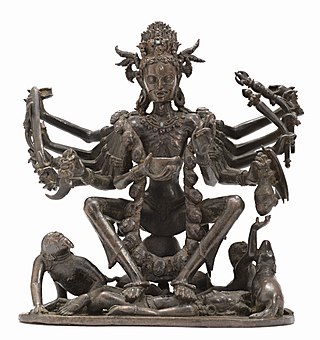
Chamunda, also known as Chamundeshwari, Chamundi or Charchika, is a fearsome form of Chandi, the Hindu mother goddess, aka Shakti and is one of the seven Matrikas.

Dewas is a city in the Malwa region of the Indian state of Madhya Pradesh. The municipality was formerly the seat of two 15-Gun Salute state princely states during the British Raj, Dewas Junior state and Dewas Senior state, ruled by the Pawar clan of the Marathas. The city is the administrative capital of Dewas district. Dewas is an industrialised city and houses a government bank note press.
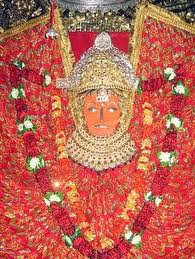
Jeenmata is a village in Sikar district of Rajasthan, India. It is located at a distance of 29 km from Sikar town in south. There is an ancient Temple dedicated to Shree Jeen Mataji. Millions of devotees come here during Navaratri. There are a number of dharamshalas to accommodate large number of visitors.

Sundha Mata temple is a nearly 900-year-old temple of Mother goddess Chamunda situated on a hilltop called Sundha, located at Longitude 72.367°E and Latitude 24.833°N, in Jalore District of Rajasthan. It is 64 km (40 mi) from Mount Abu and 20 km (12 mi) from the town of Bhinmal.
Filmi devotional songs are devotional songs from Hindi movies, or Hindi songs composed to be sung using the melody in a popular filmi song.
Bijasan Mata Temple is one of the temples of the Hindu goddess Durga, situated in Indore District of Madhya Pradesh, India. This temple is built in the year 1760 by Shivaji Rao Holkar. This temple is visited by thousands of devotees during Navaratri.
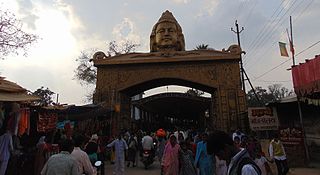
Mahamaya Temple is a temple dedicated to Goddess Durga, Mahalaksmi located at Ratanpur of Bilaspur district in Chhattisgarh, India and is one of the 52 Shakti Peethas, shrines of Shakti, the divine feminine, spread across India. Ratanpur is a small city, full of temples and ponds, situated around 25 km from district Bilaspur of Chhattisgarh.Goddess Mahamaya is also known as Kosaleswari, presiding deity of old Daksin Kosal region.

The Sikri Mata Temple, officially known as the Shri Mahamaya Devi Temple, is a Hindu temple at Sikri Khurd village, Ghaziabad district, Uttar Pradesh, India. The temple was built in the 17th century by Jalim Giri Baba and his family, who belonged to the Goswami community of the village. Its administration was taken over from the descendants of Giri Baba by the gram panchayat in 1977. Dedicated to the goddess Sikri, who is believed to be an incarnation of Durga, the temple attracts large gatherings of visitors during the biannual festival of Navaratri. During the Chaitra month of Navaratri, marking the beginning of a new year on the Hindu calendar, a large historical fair is organised for nine days. The fair was cancelled in 2020 due to the COVID-19 pandemic for the first time since 1918. There is a banyan tree on the temple premises from which more than 130 revolutionaries were hanged to death during the Indian Rebellion of 1857.
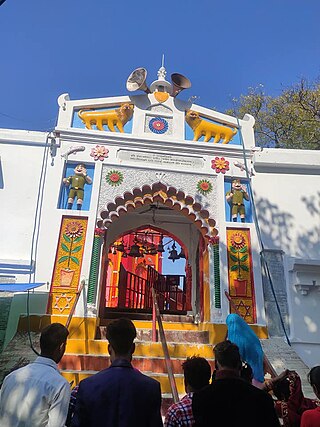
Durgan Dham Temple or Durgan Mandir is a Goddess Durga Mata temple located at Lugri, Rohnsi Bujurg, Gauriganj, Amethi district in Uttar Pradesh, India. A big fair is organized here every Monday or Friday along with Chaitra Navratri and Kuwar Navratri of Maa Durga Bhavani Dham, while lakhs of devotees from far and wide come here for the darshan and blessings of Maa Bhavani, people believe that by coming here, Maa Bhavani. Siddha Peeth Durgan Dham, located at a distance of 5 km from the city of Gauriganj, is a holy pilgrimage site of mythological Hindu religion, here the idols found in ancient times in the temple courtyard provide a great amount of authenticity to the fact. In Navratri, there is a crowd of devotees of the mother, as well as every Monday, the crowd in the form of a fair comes to see the mother, the lake located behind the temple, and the beautiful lotus flowers blooming in it attract people. A huge crowd gathers here on the occasion of Chaitra Navratri and Shardiya Navratri. This temple is being considered to be renovated.

Mata Mawai Dham is a Hindu temple of Goddess Durga Ji located in Mawai Village, Raibareli - Sultanpur Road, Near Amethi district Headquarter Gauriganj in Uttar Pradesh, India. The temple is situated at a distance of about 125 km from the State capital Lucknow and 550 km New Delhi, 100 km from Ayodhya.This magnificent temple dedicated to Durga Mata, is the center of people's faith and spirituality. Mata Mavai Dham established four decades ago in Jethu Mawai village of the area, has become the center of faith of the devotees. Devotees come and visit this place of worship from all over the country and even the countries abroad, especially in Navratris.
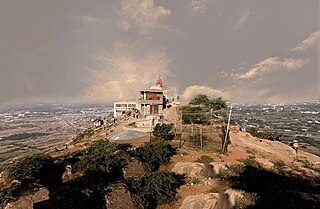
Savitri Mata Mandir or Savitri Temple is a Hindu temple of Goddess Savitri located in ratnagiri hill which is a popular pilgrimage site, Pushkar, Ajmer, Rajasthan, India. Savitri Mata Mandir is a hilltop Hindu temple. The temple is situated at an elevation of about 750 ft and a flight of 970 steps to Savitri temple, which is one of the most significant temple in India. Idols of both the wives of Lord Brahma named Savitri and Gayatri are established in this temple.

The ropeway in India is a public transportation system where cabins, gondolas or open chairs are hauled above the ground with the help of cables. India's Parvatmala Scheme, the world's largest ropeway project, envisages spending ₹1,250 billion (US$16 billion) in public–private partnership (PPP) mode over five years till 2030 to build 200 new ropeway projects of more than 1200 km length, which will decongest the traffic in narrow roads of big cities and provide cheaper connectivity in mountainous and touristy areas. Since 30% of India is covered by mountains, the ropeways are specially useful in mountainous areas, where it is difficult to build roads or railway, as lower cost and higher Return on investment (ROI) projects. Rajgir Ropeway in Bihar, 333m-long chairlift ropeway built in 1960s, is India's first ropeway. As of 2024, the 4km-long Auli Ropeway in Uttarakhand is India's longest and world's the second-longest ropeway behind Vietnam's 7,899.9 m long Hòn Thơm cable car, and when completed the under-construction 5.5km-long Mussoorie-Dehradun Ropeway will be the longest in India. Kashi ropeway is India's first urban ropeway, and world's third urban public transport ropeway behind Bolivia's Mi Teleférico opened in 2014 and Mexico City's Mexicable opened in 2021. This article also contains a list of "glass bridges in India", which are mostly glass bridge skywalk.
"Chirja" is a devotional song in Rajasthani and Gujarati literature as a prayer to the female form of divine, Shakti. Chirja is a new poetic form in Shakti-Kavya in Rajasthani literature. Chirjas are primarily sung by women especially during Jagrans during the worship of goddess. The word Chirja is derived from the Sanskrit term Charya.
Shree Rajrajeshwari Maa Mahamaya Devi Mandir Raipur or popularly Mahamaya Temple is a Hindu Temple dedicated to Devi Mahamaya located at Purani Basti, Raipur, Chhattisgarh. It is one of the 36 Shaktipeeths or 36 forts of Chhattisgarh. Built between 17th-18th Century by Maratha Ruler Mordhwaj, it is one of the oldest and the richest temple of Raipur. There two temple in temple, Mahamaya Mandir and Samaleswari Mandir. During sunset, Sun rays touches the feet of Maa Mahamaya and during sunrise, rays touches feet of Maa Samaleswari.
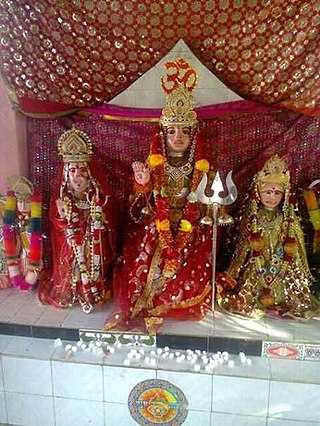
Dhabbawali Mata Temple is a famous Hindu temple located in the Sanchore district of Rajasthan, India. The idol of Goddess Dhabbawali Mata is installed in it. It is situated at Khasarvi, 35km north-west of District Sanchore. A Goddess Peeth on the revered land of Rajasthan, which is situated on the holy land of village Khasarvi of district Sanchore.
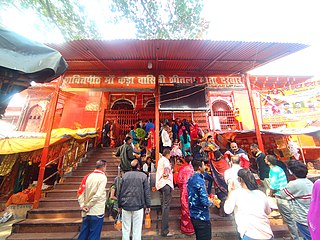
Sheetla Devi Temple is a Hindu temple dedicated to the mother goddess Shitala, located in Kara, a town located near Sirathu, on the banks of river Ganges in Kaushambi district of Uttar Pradesh. It is one of the 51 Shakti Peethas in Shaktism denomination of Hinduism. The deity of the temple is regarded as the Kuldevi of Purvanchal. It is also known as Kada Dham, Sheetlan and Sheetla Dham, Kada.

Shri Kamaksha Temple Jaidevi, also known as the Kul Devi of the Suket royal family and the Raj-Rajeshwari and Adhisthatri Devi of the Suket principality, is a historic Hindu temple surrounded by mountains in a natural setting.

Aranya Devi Temple is a Hindu temple located in Arrah of Bihar in India. Ara, the headquarters of Bhojpur district is named after the goddess of this temple. The goddess established here is considered to be the presiding deity of the city and is the deity of the people there.
Chauth Mata Temple is a Hindu temple located at a distance of about 5 kilometers from Bundi district headquarters in Rajasthan, India. The temple is dedicated to Chauth Mata, a manifestation of Hindu Goddess Parvati.
Bijasan Mata Temple is a renowned Hindu temple situated in the town of Indragarh, nestled amidst the scenic landscape of Bundi district in the Indian state of Rajasthan. The temple is dedicated to Bijasan Mata, which is another name of Hindu Goddess Durga. Goddess Durga beheaded the demon named Raktabija, after that she made that demon a seat and sat on it, hence she came to be known by the name Bijasan Mata.
















